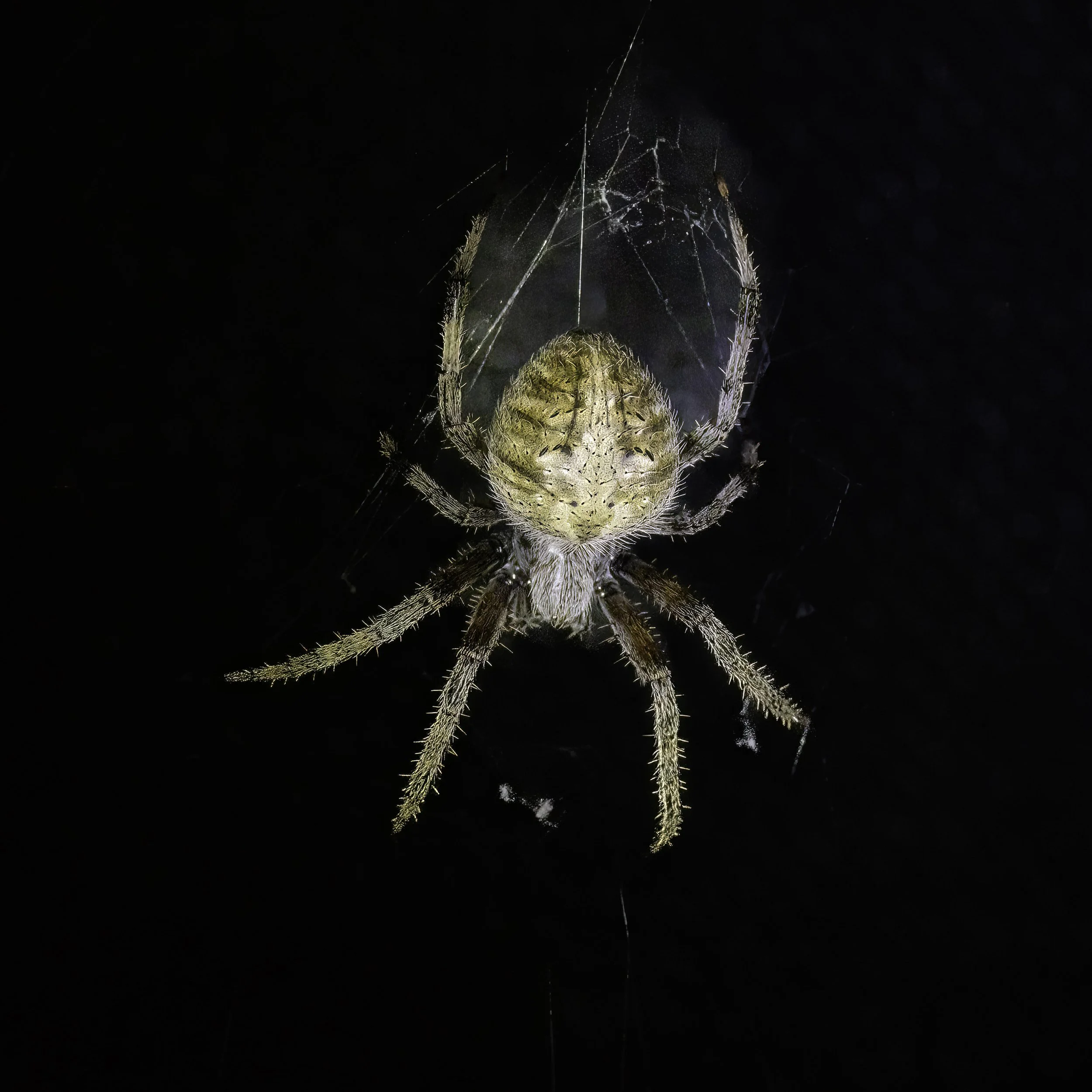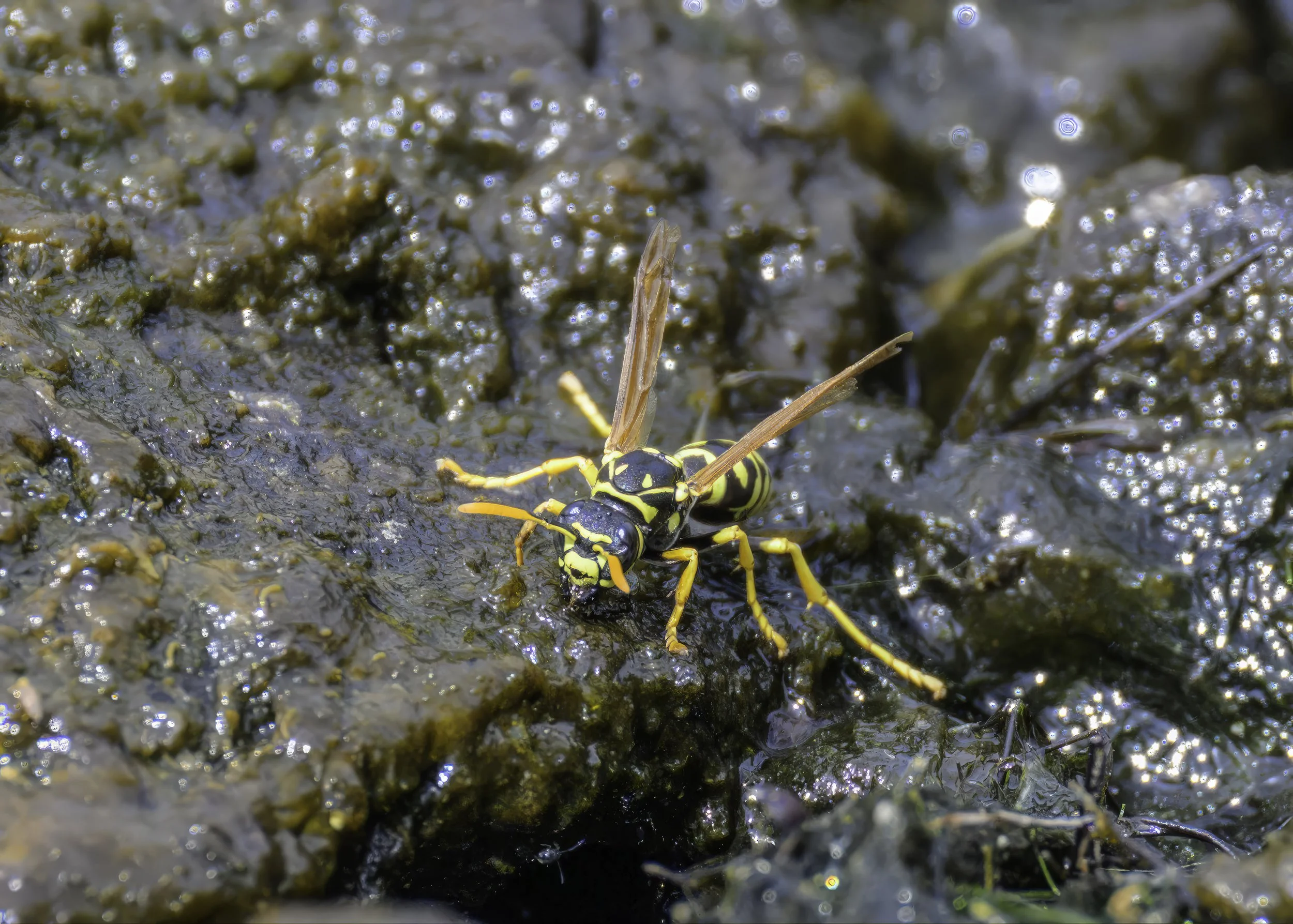Spiders eating fish…Wasps eating spiders
One of the readers of this blog submitted a comment about how she was enjoying the concentration on subjects other than birds during these hot summer days….specifically insects. She also sent along a picture she had taken of a spider she found at her house and that got me thinking about the fact that I had not found or photographed any arachnids. So now I had a new goal.
That evening, I scouted out the area around our back deck in search for spiders and as luck would have it I found a beautiful specimen of a Spotted orb weaver. The spotted orb weaver is a common spider species named for its distinctive, intricate web patterns and characteristic spotted abdomen. Typically found in gardens, forests, and fields across the United States, this spider plays a crucial role in controlling insect populations. Its web, often built in the early evening, is used to capture flying insects, which the orb weaver quickly immobilizes with venom before consumption. The spotted orb weaver’s coloration varies but usually features a combination of brown, tan, and white markings, aiding in camouflage against tree bark and foliage. This species is generally non-aggressive and poses little threat to humans, making it an interesting subject for nature photography.
Spotted orb weaver Nikon Zfc with Z DX50-250mm lens 1/1000 sec, f/8, ISO 8000
Rather than using a flash, I had my wife hold a flashlight on the subject and shot the image at close range. The background failed to show the intricate web with any clarity so I simply darkened the context to bring out the detail in the spider. I’ll continue to monitor this spider and see if I can capture an image of the web and/or hunting activity of this spider later this week.
The next day, I went up Cragston Ponds since it was a weekend and I try to avoid Harriman and Bear Mt crowds on Saturday and Sunday. Those ponds have proven to be very productive for photographing dragonflies, bees and wasps, so I am always looking for new species of those insects. It did not take long to find a new addition to this year’s collection.
Double-banded scoliid wasp
First glimpse made me think I was looking at a Four-banded stink bug wasp found and reported on earlier in the blog. A closer look quickly revealed that this wasp had two bands not four, and so I began shooting. Turns out that this is a Two-banded scoliid wasp. The Two-banded scoliid wasp is a distinctive species recognized by its striking black body with two prominent yellow bands across its abdomen. These wasps are solitary and play a vital role in natural pest control by parasitizing beetle larvae, particularly those of scarab beetles. They are often found in open fields and gardens during the warmer months, where their robust bodies and vivid markings make them relatively easy to identify. Like many solitary wasps species, two-banded scoliid wasps are generally non-aggressive towards humans.
European Paper wasp
Yet another wasp species I found today was the European Paper wasp. The European paper wasp (Polistes dominula) is a common species known for its striking black and yellow markings and slender body. Native to Europe and parts of Asia, it has successfully spread to North America and other regions, often outcompeting native wasp species. European paper wasps build umbrella-shaped nests from chewed plant fibers mixed with saliva, creating a papery texture. These nests are typically found in sheltered areas such as eaves, attics, or shrubs. The wasps are beneficial predators, feeding on caterpillars and other insects, which helps control pest populations, but they can become a nuisance when nesting close to human activity. Despite their potential for stings, they are generally less aggressive than other communal wasps unless their nests are disturbed.
Two-spotted spider wasp with Banded Fishing spider
Our final entry today involves two of the more amazing creatures we have covered over the past months. The spider seen in the photograph above is a Banded Fishing Spider. This spider is a large, semi-aquatic spider commonly found near bodies of water such as Cragston Lake where I found this individual. Named for its distinctive banded leg markings, this spider is an agile hunter that uses its ability to walk on water to catch prey including insects and small fish. Its keen sensory hairs detect vibrations on the water’s surface, allowing it to precisely locate and capture food. While impressive in size, the banded fishing spider is generally non-aggressive toward humans. Below is a video produced by the Smithsonian Institution which shows the Fishing spider in action.
The wasp in the image is a Two-spotted spider wasp. In spite of being considerably smaller in size than the spider, this wasp has hunted down and imobilized the much larger spider which it will now drag back to its underground nest. The wasp then lays a single egg on the still-alive spider and buries the egg and its food supply. The larva will dine upon the spider, saving the vital organs for last in order to keep the spider alive and its “meat” fresh. It is indeed a jungle out there!
In closing, the video below produced by the Smithsonian Institution demonstrates how the fishing spider goes about its practice of catching and eating fish. Check it out!



